Hypertrichosis Dallas
Hypertrichosis refers to the excessive hair growth that occurs beyond the accepted limits of normal for a particular age, race, and sex. In contrast, hirsutism refers to the excessive hair in women in anatomic sites that would be characteristic of male secondary sexual distribution.
Congenital or Hereditary Hypertrichosis
Congenital hypertrichosis lanuginosa refers to a condition in which hypertrichosis occurs as a generalized and confluent presentation of hair across the body except in regions where hair is not normally found at all (glans penis, labia minora, lips, tips of fingers, palms and soles). The hair is usually silvery gray to blond in color and grows away from the midline. The condition may be associated with dental problems, infantile genatalia, and growth and mental retardation but in most cases does not carry these associations.
A subtype of congenital hypertrichosis lanuginosa include Ambras syndrome (or hypertrichosis universalis congenita) in which there is persistent, confluent long hair (4 to 10 inches in length) especially over the shoulders and face. Unusual facial features may be present under the long hair, and accessory nipples may also be found.
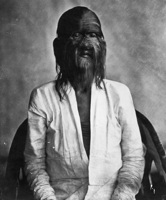

Another type of congenital hypertrichosis lanuginosa is found in a Mexican family (congenital generalized hypertrichosis) in which the abnormal hair is much shorter than in Ambras syndrome and curly versus straight. Females tend to show a patchy hypertrichosis compared with men who have a more confluent presentation.
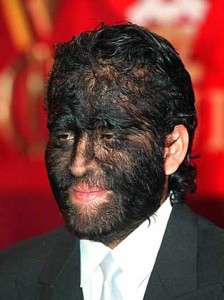
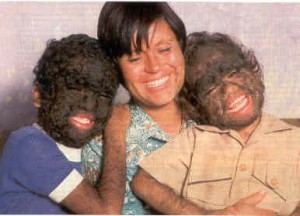
Hereditary gingival fibromatosis (in which the gums are overgrown) can be associated with generalized hypertrichosis. Hypertrichosis is usually not as severe as in cases of congenital hypertrichosis lanuginosa and can appear as late as puberty, involving mainly the eyebrows, face, limbs, and midback.
Besides hereditary versions of hypertrichosis, in utero exposure to toxins like fetal alcohol syndrome can be associated with hirsutism (>5% incidence) and children with holoprosencephaly can be born with hypertrichosis.
Acquired Hypertrichosis
Acquired generalized hypertrichosis may rarely be derived from lanugo hair but more commonly vellus hair. In 1865, Turner first noted the association between lanugo hypertrichosis and malignancy (acquired hypertrichosis lanuginosa or “malignant down”), which can be a late manifestation of widely disseminated cancer. Occasionally, the abnormal lanugo hair may be the presenting sign of cancer and predate the diagnosis of cancer even by several years.
| Types of Malignancies associated with Acquired Hypertrichosis Lanuginosa |
|---|
|
Bladder
|
|
Breast
|
|
Colon
|
|
Gallbladder
|
|
Liver- adenocarcinoma
|
|
Lung
|
|
Lymphoma/Leukemia
|
|
Ovary
|
|
Pancreas
|
|
Rectum
|
|
Uterus
|
|
Renal Cell Carcinoma
|
Hypertrichosis Lanuginosa
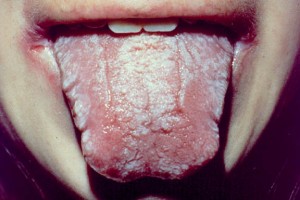
Many cases of acquired hypertrichosis lanuginosa have been associated with tongue abnormalities like a burning or painful tongue, thickened papillae, abnormal pigmentation, and deep furrows. When tongue findings are seen to accompany generalized lanugo hair, an active investigation into the possibility of cancer should be undertaken. Unlike in many congenital syndromes, the hair is pale or colorless without significant length (in most cases). Regression of this abnormal lanugo hair has been seen in patients following surgical removal of the cancer.
Drugs have also been associated with hypertrichosis. Minoxidil used orally to treat severe high blood pressure was found to show hypertrichosis in over 80% of patients within weeks to months of beginning treatment, affecting the face, shoulders, arms, and legs in more men than women. Topical minoxidil used for female pattern baldness has been associated with facial hypertrichosis more commonly with the 5% than with the 2%. Hypertrichosis that develops following oral or topical minoxidil tends to regress within several months following cessation of minoxidil.
Diazoxide, which like minoxidil is a potassium channel opener and is a vasodilator, is used to treat hypoglycemia (low sugar levels) in infancy. Hypertrichosis is seen more commonly in children and less frequently in treated adults with growth over the forehead, nape of neck, eyebrows, eyelashes, and back of the trunk and limbs. The hair is in general lanugo-like but may exhibit pigmentation with reported persistence of up to a year following stopping the medication.
Phenytoin (Dilantin) can exhibit abnormal hair growth in 5 to 12% of cases that may be unrelated to dosage or serum concentration of the drug. The excessive hair growth is seen primarily on the arms and legs but can be evident on the trunk and face as well. Following head injury in patients treated with Dilantin, abnormal hair growth has been observed. Interestingly, even in cases of head injury without the use of Dilantin, individuals have exhibited hypertrichosis.
Patients treated with cyclosporine have exhibited hypertrichosis in 44 to 60% of cases following organ transplantation. Hair growth is diffuse but primarily targets the shoulders, back, upper arms, face, scalp, eyebrows, and earlobes. Hypertrichosis commences about 2 to 4 weeks after beginning the drug and increases over the first 3 months with rare onset after that time.
Treatment with psoralen in combination with ultraviolet light (PUVA) used to manage vitiligo and psoriasis has been associated with hypertrichosis. Hair growth is more prevalent in the face and arms/legs than elsewhere. Streptomycin used to treat tuberculosis and acetazolamide (Diamox) used for glaucoma have also been associated with hypertrichosis.
Certain systemic diseases like porphyria can manifest hypertrichosis in 63% of patients, involving primarily the temples, cheeks, eyebrows, and hairline but may involve the trunk and arms/legs. Porphyria cutanea tarda is the most common type of porphyria that shows as a bullous skin eruption in sun-exposed areas that arises due to a deficiency in the enzyme uroporphyrinogen decarboxylase. Another illness, POEMS syndrome, has also been associated with hypertrichosis. Children with hypothyroidism have been found in several case reports to manifest hypertrichosis over the back and arms/legs that resolved with therapy. Children with intestinal malabsorption like celiac disease and a woman with anorexia nervosa have been found to have diffuse lanugo-like hypertrichosis.
Congenital Localized Hypertrichosis
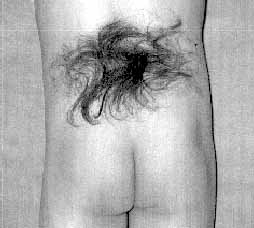 Faun tail describes hair growth over the lower back that can be associated with an underyling spinal defect like spina bifida or other conditions. The faun tail may appear in the general region of the neurologic defect and not at its precise level. Further, the presence of a faun tail should raise suspicion for a neurologic deformity even if one is not obviously observed.
Faun tail describes hair growth over the lower back that can be associated with an underyling spinal defect like spina bifida or other conditions. The faun tail may appear in the general region of the neurologic defect and not at its precise level. Further, the presence of a faun tail should raise suspicion for a neurologic deformity even if one is not obviously observed.
Congenital hair on the elbows (hypertrichosis cubitii) presents as lanugo hair at birth and transforms into thicker, darker terminal hairs during childhood and then usually regresses. Onset has occurred as late as 5 years old and has been associated with short stature.
Anterior cervical hypertrichosis describes excessive hair that occurs over the adam’s apple of the neck usually between birth to 3 years of age and can be associated with Turner’s syndrome.
Congenital hair on the external ears is commonly encountered in populations of the Pacific Islands, South India, Sri Lanka as well as European, African, and Australians. In addition, babies with an XYY syndrome or who are born to diabetic mothers may have a higher likelihood of this condition. Congenital pigmented hairy nevi (nevi pilorum) is perhaps the most common cause of localized hypertrichosis in infants.
Acquired Localized Hypertrichosis
Various types of physical trauma may cause a temporary hypertrichosis in the affected area. Repeat trauma or irritation may cause localized change from vellus to terminal hairs. In addition, prolonged occlusion of a limb by a cast can also generate hypertrichosis in the limb. Reflex sympathetic dystrophy has also been associated with localized hypertrichosis.
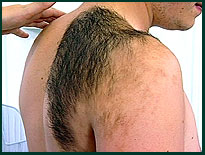 Becker’s nevus describes a condition in which a localized hypertrichosis and hyperpigmentation can occur during adolescent areas primarly in the shoulder area (although they can occur elsewhere and can occur with multiple lesions). The rise of this condition during puberty and the occasional presence of acne within the lesion raises the question of an androgen-mediated process.
Becker’s nevus describes a condition in which a localized hypertrichosis and hyperpigmentation can occur during adolescent areas primarly in the shoulder area (although they can occur elsewhere and can occur with multiple lesions). The rise of this condition during puberty and the occasional presence of acne within the lesion raises the question of an androgen-mediated process.
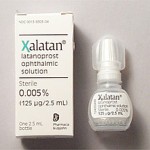 Latanoprost, an analog of prostaglandin F-2alpha, used to treat chronic open angle glaucoma can lead to hypertrichosis and hyperpigmentation of the eyelashes. Hypertrichosis can persist even after cessation of the drug.
Latanoprost, an analog of prostaglandin F-2alpha, used to treat chronic open angle glaucoma can lead to hypertrichosis and hyperpigmentation of the eyelashes. Hypertrichosis can persist even after cessation of the drug.
Hypertrichosis Treatment Options
Shaving and plucking may help correct hypertrichosis. However, shaving provides only a temporary solution and may be negatively associated with a male ritual. Plucking is impractical for a large area and can also change telogen to anagen hairs making the area grow even more actively not to mention local irritation and discomfort associated with plucking.
Depilation involves a painless chemical dissolution of hair by leaving a chemical depilatory on the skin for 3 to 15 minutes and wiping the jelly-like mass of dissolved hair off with a spatula. The main drawback is the potential for an irritant dermatitis, which can be particularly acute in the area around the mouth. Depilatories should not be used more often than every other day owing to the potential for irritation, and the area should be thoroughly rinsed and topical emollients or 1% hydrocortisone cream applied to minimize irritation further.
Electrolysis can offer a permanent form of epilation. Use of galvanic current directed at the hair follicle produces NaOH and H2 gas with the NaOH causing destruction to the hair follicle. The damaged hair is then easily extracted from the follicular tract with forceps. Regrowth has been noted to be between 15 to 50% depending on the quality of the technician and equipment.
Laser hair removal is undertaken using a wavelength that targets the pigment in the hair shaft while minimizing damage to the surrounding skin pigment. The ideal laser should have a pulse duration that can be between the thermal relaxation time (TRT) of the skin and the TRT of the hair follicle. The ruby laser (694 nm), the alexandrite laser (755 nm), and the semicondutor diode laser (800 nm) are used to target the melanin, whereas the Nd:YAG laser targets a topically applied preparation.
The FDA has approved laser hair removal devices to provide “permanent hair reduction”, meaning the lasting reduction of treated hairs for a period greater than one complete hair cycle. With the ruby and diode lasers, most of the damage occurs at the level of the bulge and less at the bulb/dermal papilla of the hair follicle. The laser hair removal device provides hair reduction via both reduction in the number of terminal hairs and the conversion of terminal hairs into vellus hairs.




